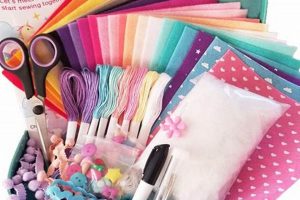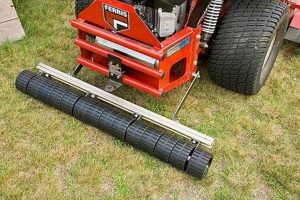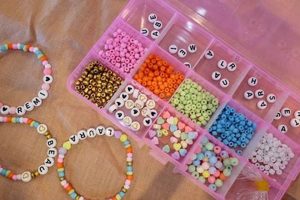A collection of materials and tools designed for creating mosaic art projects at home is commonly available. These sets typically include tesserae (small pieces of glass, tile, or other materials), an adhesive, a base or substrate, and instructions. For example, a kit might provide pre-cut glass squares, glue, and a wooden tray for constructing a decorative serving piece.
Engaging in this artistic practice fosters creativity, provides a relaxing activity, and results in personalized decorative items. The art of creating images or designs from an assemblage of small pieces of colored material has historical significance, dating back to ancient civilizations who used mosaics to adorn walls and floors with intricate patterns and scenes. The kits make this historical art form accessible to hobbyists.
The following sections will delve into the components typically found within these sets, explore the diverse range of projects that can be undertaken, and offer guidance on selecting the appropriate kit for individual skill levels and artistic preferences.
Essential Considerations for a Successful Mosaic Project
Achieving optimal results with a do-it-yourself project requires careful planning and execution. The following guidelines aim to maximize the likelihood of a satisfying outcome.
Tip 1: Material Selection is Paramount. The choice of tesserae should align with the intended application and aesthetic. Glass tiles offer vibrant colors and durability for outdoor use, while ceramic provides a matte finish suitable for indoor projects. Ensure the tesserae are uniform in thickness for a level surface.
Tip 2: Substrate Preparation is Crucial. The base onto which the tesserae are applied must be clean, dry, and structurally sound. Porous surfaces, such as wood, benefit from a sealant application to prevent moisture absorption and adhesive failure.
Tip 3: Adhesive Selection Matters. The adhesive should be compatible with both the tesserae and the substrate. Consider factors such as water resistance, drying time, and flexibility. For vertical surfaces, a high-viscosity adhesive is recommended to prevent slippage.
Tip 4: Design Planning Prevents Errors. Before adhering any tesserae, create a detailed design, either on paper or directly on the substrate. This step allows for adjustments and minimizes wasted materials. Consider using a grid system for intricate patterns.
Tip 5: Precise Cutting Enhances Aesthetics. When cutting tesserae, utilize appropriate tools, such as tile nippers or a wet saw, to achieve clean, precise cuts. Avoid jagged edges, which detract from the overall appearance. Safety glasses are essential during cutting operations.
Tip 6: Proper Spacing Ensures Grout Adhesion. Maintain consistent spacing between the tesserae to allow for adequate grout penetration. Excessive spacing can weaken the structure and detract from the design. Use tile spacers to ensure uniformity.
Tip 7: Grouting Enhances Durability and Appearance. Select a grout color that complements the tesserae. Apply the grout evenly, ensuring it fills all gaps. Remove excess grout promptly to prevent staining. Allow the grout to cure fully before exposing the mosaic to moisture.
These fundamental aspects of a well-executed mosaic endeavor not only contribute to the visual appeal of the finished item but also ascertain its lasting quality.
The following part will give the different types of kits and ideas for using them.
1. Tesserae Material
The tesserae material within a do-it-yourself mosaic kit directly influences the aesthetic outcome, durability, and overall suitability of the completed project. The choice of material whether glass, ceramic, stone, or another substance dictates the color palette, texture, and resistance to environmental factors. For example, a kit containing glass tesserae is well-suited for outdoor projects due to its inherent water resistance and colorfastness, while a kit with ceramic tiles may be preferable for indoor applications due to its softer appearance and ease of cutting. The material’s composition also affects the required adhesive and grouting techniques.
The significance of tesserae material extends beyond mere aesthetics. The size, shape, and uniformity of the tesserae impact the complexity of the design and the ease of assembly. A kit containing irregularly shaped stone tesserae may demand a higher level of skill and patience compared to a kit with precisely cut glass tiles. Furthermore, the material’s thermal expansion properties should be considered, particularly for projects exposed to temperature fluctuations. Inconsistent expansion rates between the tesserae and the substrate can lead to cracking and detachment over time. A high-quality mosaic kit will typically specify the material’s properties and provide guidance on appropriate adhesives and grouts.
In summary, the selection of tesserae material is a critical factor in the success of a mosaic project. The material’s properties directly impact the aesthetic appeal, durability, and ease of assembly. Therefore, careful consideration should be given to the intended application and desired outcome when choosing a do-it-yourself mosaic kit. Understanding the characteristics of different tesserae materials empowers the user to make informed decisions and achieve professional-looking results, ensuring long-lasting and visually appealing mosaic art.
2. Adhesive Quality
The adhesive’s quality is a critical determinant of a successful mosaic project. Within a do-it-yourself setting, the adhesive functions as the primary bonding agent between the tesserae and the substrate. Insufficient adhesive strength leads to tesserae detachment, compromising the aesthetic integrity and structural soundness of the final product. An example includes using a general-purpose craft glue instead of a specialized mosaic adhesive, resulting in tile slippage during the drying process and subsequent weakening of the bond over time. The adhesive must maintain its bonding properties under varied environmental conditions, including temperature and humidity fluctuations. The selection of a subpar adhesive represents a false economy, as the remedial work necessitated by its failure often exceeds the initial cost savings.
The choice of adhesive necessitates consideration of several factors, including the tesserae material (glass, ceramic, stone), substrate material (wood, tile, concrete), and intended environment (indoor, outdoor, submerged). Certain adhesives are formulated for specific material combinations, optimizing adhesion strength and preventing chemical reactions that degrade the bond. For instance, applying a water-based adhesive to a non-porous surface, such as glass, inhibits proper curing and significantly reduces bond strength. Likewise, exposure to moisture can weaken or dissolve water-soluble adhesives, rendering them unsuitable for outdoor mosaics. The selection p
rocess should also account for the adhesive’s open time, or the duration during which the tesserae can be repositioned without compromising the bond. An adhesive with an inadequate open time forces rapid tesserae placement, increasing the likelihood of errors and design flaws.
In summary, the selection and application of a high-quality adhesive are paramount for achieving a durable and aesthetically pleasing mosaic. Proper adhesive selection accounts for the composition of tesserae and the substrate, as well as the environmental factors to which the finished piece will be exposed. A well-chosen adhesive assures a long-lasting, visually appealing mosaic. Conversely, an inadequate adhesive almost invariably leads to project failure, incurring additional expense and frustration. Diligence in researching and selecting a suitable adhesive is an investment in the project’s long-term success.
3. Base Stability
The structural integrity of a completed mosaic piece is inextricably linked to the stability of its base. Within the context of a “diy mosaic kit,” the base serves as the foundational support upon which tesserae are affixed. Compromised base stability precipitates a cascade of potential issues, including cracking, warping, and ultimately, the detachment of tesserae. Consider, for example, a kit designed for creating a mosaic tabletop. If the wooden base lacks adequate thickness or is constructed from a low-density material, it is susceptible to deformation under load or environmental changes, negating the aesthetic value of the mosaic and shortening its lifespan. Thus, base stability is not merely an ancillary attribute but a fundamental prerequisite for project success.
The selection of an appropriate base material necessitates careful consideration of several factors. The weight of the tesserae, the intended environment of the finished mosaic, and the desired longevity all play a role. For outdoor mosaics, moisture resistance and thermal stability are paramount, often favoring materials such as concrete backer board or treated wood. Indoor projects may permit the use of less robust materials, such as MDF or plywood, provided they are properly sealed and reinforced. Furthermore, the base’s surface must be adequately prepared to ensure proper adhesion. This preparation may involve sanding, priming, or the application of a bonding agent to create a textured surface that promotes mechanical interlock with the adhesive. Failure to properly prepare the base can lead to premature adhesive failure and subsequent tesserae detachment.
In summary, base stability is a non-negotiable element of a successful mosaic project initiated from a “diy mosaic kit.” A structurally sound base provides the necessary support to withstand environmental stressors and mechanical loads, ensuring the mosaic’s longevity and aesthetic appeal. The careful selection and preparation of the base material represent a critical investment in the project’s long-term durability, mitigating the risk of structural failure and maximizing the return on effort invested in the mosaic creation process. Ignoring base stability introduces a significant risk of project failure, regardless of the quality of other components within the kit.
4. Tool Inclusion
Tool inclusion within a “diy mosaic kit” directly determines the accessibility and completeness of the mosaic creation process. The presence or absence of essential tools significantly impacts the user’s ability to execute a project effectively and achieve desired results. The quality and type of tools included reflect the kit’s overall value and suitability for various skill levels.
- Tile Nippers/Cutters
These tools facilitate the shaping and sizing of tesserae. Tile nippers allow for the precise trimming of glass or ceramic tiles, enabling the creation of intricate patterns and designs. Without appropriate cutting tools, users are limited to pre-cut shapes, restricting creative expression. For example, a kit intended for complex designs would necessitate the inclusion of high-quality nippers capable of producing clean, accurate cuts. The absence of such tools diminishes the kit’s versatility and increases the likelihood of project failure due to ill-fitting tesserae.
- Adhesive Applicators
The inclusion of spatulas, spreaders, or syringes ensures controlled and even adhesive application. These tools prevent over-application, which can lead to unsightly residue and compromised structural integrity. For example, a kit designed for small, detailed mosaics would benefit from a fine-tipped applicator, allowing for precise placement of adhesive without obscuring the design. The absence of suitable applicators can result in messy and uneven bonding, detracting from the overall aesthetic and potentially weakening the mosaic’s structure.
- Grout Spreaders/Sponges
These tools are essential for the application and removal of grout, the material used to fill the spaces between tesserae. A grout spreader ensures even distribution, while a sponge facilitates the removal of excess grout from the tile surfaces. The inclusion of appropriate grout application tools contributes to a clean, professional finish. For instance, a kit intended for larger projects would necessitate a wider grout spreader and a larger sponge to efficiently manage the grouting process. Neglecting to include these tools can result in uneven grout lines and a lack of definition in the final mosaic.
- Safety Glasses
Eye protection is paramount when working with mosaic materials, particularly during the cutting and shaping of tesserae. Safety glasses shield the user’s eyes from shards and debris, mitigating the risk of injury. While seemingly a minor inclusion, safety glasses demonstrate a commitment to user safety and responsible kit design. A “diy mosaic kit” that omits this essential safety item overlooks a crucial aspect of the crafting process, potentially exposing users to unnecessary harm.
The inclusion of appropriate tools within a “diy mosaic kit” is not merely a matter of convenience but a determinant of project success, user safety, and creative potential. A well-equipped kit empowers users to execute their designs effectively, achieve professional-looking results, and enjoy a safe and fulfilling crafting experience. Conversely, a kit lacking essential tools compromises the user’s ability to fully realize their artistic vision and increases the risk of project failure or injury.
5. Design Complexity
Design complexity within a “diy mosaic kit” context refers to the intricacy of patterns, the variety of tesserae shapes and sizes, and the level of skill required to execute the intended artistic vision. The complexity level significantly impacts the user’s experience, project completion time, and the final aesthetic outcome. Choosing a kit with an appropriate level of design complexity is crucial for ensuring a satisfying and successful mosaic creation process.
- Number of Tesserae and Color Palette
A more complex design typically involves a greater quantity of tesserae and a broader color palette. This increased variety allows for finer details and nuanced shading, enhancing the visua
l depth and realism of the mosaic. However, it also demands more meticulous organization and placement, potentially extending the project’s duration. A simple design might utilize a limited number of tesserae in a few basic colors, making it suitable for beginners. A complex design, on the other hand, could involve hundreds or even thousands of tesserae in a wide range of hues, requiring advanced organizational skills and attention to detail. For example, a simple geometric pattern using pre-cut square tiles is less complex than a portrait rendered with irregularly shaped glass pieces in numerous shades. - Tesserae Shape and Size Variations
Complex designs frequently incorporate tesserae of varying shapes and sizes. This allows for greater flexibility in creating curves, angles, and intricate patterns. However, it also necessitates more precise cutting and fitting, demanding a higher level of dexterity and experience. A “diy mosaic kit” containing only square tiles offers limited design options compared to a kit with a mixture of squares, triangles, and other shapes. The use of irregularly shaped tesserae, such as broken glass or natural stone, further increases the design complexity, requiring the user to adapt to variations in size and thickness. An intricate landscape mosaic, for instance, may employ a combination of small, irregularly shaped pieces to create a realistic texture and depth.
- Pattern Intricacy and Level of Detail
The complexity of the pattern itself contributes significantly to the overall design complexity. Simple geometric patterns are generally easier to execute than intricate representational designs. The level of detail required to accurately reproduce an image or pattern also impacts the difficulty. A “diy mosaic kit” featuring a pre-printed template simplifies the process, but it still demands careful placement of tesserae to match the design. Complex designs, such as portraits or detailed landscapes, require meticulous attention to detail and a high level of artistic skill. These designs often involve subtle variations in color and texture to create a realistic effect. The level of pattern intricacy should align with the user’s skill level and patience.
- Adhesive and Grouting Techniques
More complex designs may necessitate specialized adhesive and grouting techniques. For instance, vertical surfaces or intricate patterns may require the use of a high-viscosity adhesive to prevent slippage. Narrow grout lines or delicate tesserae may demand the use of a fine-tipped grout applicator to avoid damaging the mosaic. The adhesive and grouting techniques must be carefully considered to ensure the long-term stability and aesthetic appeal of the mosaic. Certain kits may include specific instructions or specialized materials to address the challenges posed by complex designs. Understanding and mastering these techniques is essential for achieving a professional-looking finish.
These facets of design complexity, when considered in relation to the “diy mosaic kit,” demonstrate the importance of matching the kit’s characteristics to the user’s skill level and artistic goals. Selecting a kit that aligns with one’s capabilities and preferences is crucial for ensuring a positive and rewarding mosaic creation experience. The degree of complexity chosen determines the level of challenge, the time investment, and the ultimate visual impact of the completed mosaic piece.
6. Grout Selection
Grout selection is a critical determinant of the final appearance, durability, and maintainability of a mosaic project undertaken with a do-it-yourself kit. The type, color, and application of grout significantly impact the aesthetic integration of tesserae, the resistance to moisture and staining, and the overall longevity of the mosaic artwork.
- Grout Type and Composition
The composition of grout dictates its performance characteristics. Cement-based grouts are common and suitable for many applications; however, they can be porous and susceptible to staining. Epoxy grouts, while more expensive, offer superior water resistance and stain protection, making them ideal for wet environments such as bathrooms and kitchens. Selecting the appropriate grout type ensures the mosaic can withstand its intended environment and maintain its aesthetic appeal. For example, using a sanded grout with delicate glass tesserae could scratch the surface, whereas an unsanded grout is more appropriate to avoid damage.
- Grout Color and Aesthetic Impact
The color of the grout significantly influences the overall appearance of the mosaic. A contrasting grout color can accentuate the individual tesserae and create a bold, graphic effect. A matching grout color can blend the tesserae together, creating a more seamless and unified look. Neutral grout colors, such as white or gray, are versatile and can complement a wide range of tesserae colors. The choice of grout color should align with the desired aesthetic outcome. For instance, a dark grout can create a dramatic contrast with light-colored tiles, highlighting their shape and arrangement.
- Application Technique and Grout Lines
Proper grout application is crucial for achieving a professional finish. Even distribution of grout, thorough filling of gaps between tesserae, and prompt removal of excess grout are essential steps. The width and consistency of grout lines can also impact the overall aesthetic. Uniform grout lines create a consistent and polished look, while varying grout line widths can add visual interest. The application technique should be carefully executed to avoid damaging the tesserae or leaving unsightly residue. Consistent grout lines showcase the pattern of tesserae more precisely. Uneven grout lines can unintentionally distract the eye. Precise grout application and removal contribute to the longevity of the mosaic.
- Sealing and Maintenance
Many grouts, particularly cement-based varieties, require sealing to protect against moisture and staining. A grout sealer penetrates the grout and creates a barrier that prevents liquids from seeping in. Regular cleaning and maintenance are also necessary to keep the grout looking its best. Neglecting to seal or clean the grout can lead to discoloration, mold growth, and deterioration of the mosaic over time. Sealing is a protective measure that extends the life of the mosaic.
In conclusion, grout selection is an integral component of any do-it-yourself mosaic project. Thoughtful consideration of grout type, color, application technique, and maintenance requirements ensures a durable, aesthetically pleasing, and long-lasting mosaic. The selection process directly influences the visual and structural integrity of the finished piece, enhancing the overall value and enjoyment derived from the completed artwork.
Frequently Asked Questions About DIY Mosaic Kits
This section addresses common inquiries concerning do-it-yourself mosaic creation, offering guidance to prospective and experienced crafters. The following questions aim to clarify potential points of confusion and provide practical information for successful mosaic projects.
Question 1: What is the typical lifespan of a mosaic created using a do-it-yourself kit?
The longevity of a mosaic is contingent upon several factors, including material quality, adhesive strength, grout selection, and environmental exposure. Properly constructed mosaics using high-quality materials can endure for decades indoors. Outdoor mosaics may exhibit shorter lifespans due to weathering and temperature
fluctuations. Sealing grout and protecting from extreme conditions enhances durability.
Question 2: Are specialized tools necessary for completing a project initiated from a “diy mosaic kit?”
While some kits provide all necessary tools, others may require supplementary equipment. Tile nippers or scorers are essential for shaping tesserae. Safety glasses are mandatory for eye protection. Adhesive applicators ensure even distribution. The specific tool requirements depend on the kit’s design complexity and material composition. Reviewing the kit’s contents and project requirements is crucial prior to commencement.
Question 3: How does one determine the appropriate adhesive for a specific mosaic project?
Adhesive selection hinges on the tesserae material (glass, ceramic, stone), the substrate material (wood, tile, concrete), and the intended environment (indoor, outdoor, submerged). Compatibility is paramount. Water-resistant adhesives are necessary for wet environments. Flexible adhesives accommodate thermal expansion. Consulting adhesive manufacturer specifications and project guidelines is advisable.
Question 4: What precautions should be taken when working with grout?
Grout can cause skin and eye irritation. Protective gloves and eye protection are recommended. Adequate ventilation is essential to minimize inhalation of dust particles. Excess grout should be removed promptly to prevent staining. Following manufacturer instructions for mixing and application is crucial for optimal results and safety.
Question 5: How does one prevent tesserae from detaching from the base over time?
Proper surface preparation, high-quality adhesive, and a stable base are essential for preventing tesserae detachment. The substrate must be clean, dry, and free of contaminants. The adhesive should be applied evenly and allowed to cure fully. The base material should be resistant to warping and cracking. Adhering to these best practices minimizes the risk of long-term bond failure.
Question 6: Can do-it-yourself mosaic kits be used for outdoor applications?
Certain “diy mosaic kit” are specifically designed for outdoor use, featuring weather-resistant materials and adhesives. However, not all kits are suitable for outdoor environments. Reviewing the kit’s specifications and intended application is critical. Protecting outdoor mosaics from extreme temperature fluctuations and moisture exposure can prolong their lifespan.
These FAQs provide a foundational understanding of essential considerations for DIY mosaic creation. Paying heed to these factors greatly enhances the likelihood of a satisfying and enduring artistic endeavor.
The following section will give you some advice to buy it.
Conclusion
The preceding exploration of “diy mosaic kit” components and considerations underscores the importance of informed selection and meticulous execution. Factors such as tesserae material, adhesive quality, base stability, tool inclusion, design complexity, and grout selection each contribute significantly to the final outcome. A comprehensive understanding of these elements empowers individuals to engage in mosaic creation with greater confidence and achieve results commensurate with their artistic aspirations.
Investing time in researching and carefully evaluating available resources prior to embarking on a mosaic project will undoubtedly yield a more rewarding and enduring creation. The principles outlined herein serve as a foundation for appreciating the art of mosaic and ensuring the longevity of self-made artworks. Future exploration of advanced techniques and material innovations will further enrich the mosaic experience.







